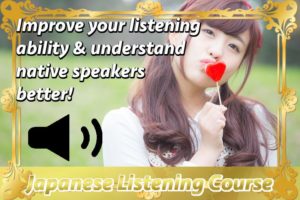話 vs. 話し:Don’t Think These Are The Same.
What is the difference between “話(hanashi) and 話し(hanashi)”? Which is used as the meaning of “story”? After reading this, you would be answering this question. Let me introduce what their subtle differences are and how you correctly use them such as native speakers today!
[wp-svg-icons icon=”checkmark-circle” wrap=”i”] 話(hanashi)
[wp-svg-icons icon=”arrow-right-2″ wrap=”span”] Story, What someone talks about, etc / 故事 / 이야기 / Câu chuyện
“話し(hanashi)” means “Story, What someone talks about, etc” and which has been used as the meaning of “An account of imaginary or real people and events told for entertainment.”. The basic ways to use it is that “___は話を聞く。(___ listen to a story.)”, etc For instance, “私は話を聞く。(I listen to a story.)”, etc. The tips for using it are that “話” is used as “A NOUN”, unlike “話し”. Everyone could use “話” as casual, polite and formal such as “話を聞いたよ。(I listened to a story.)” as casual “話を聞きました。(I listened to a story.)” as polite and formal.
話が違うよね? (That is not what we talked about, right?) (这话不对吧?) (이야기가 다르지?) (Câu chuyện thật khác, phải không?)
[/voice]
[voice icon=”http://jpyokoso.com/wp-content/uploads/2019/06/learn-japanese-online-how-to-speak-japanese-language-for-beginners-basic-study-in-japan-okawa98.jpg” name=”たつや” type=”l icon_blue” sample”]
いい話をしてくれてありがとうございます。 (Thank you for sharing such a great story!) (谢谢你告诉我一个好故事。) (좋은 말씀 해주셔서 감사합니다.) (Cảm ơn vì bạn đã kể cho tôi một câu chuyện hay.)
[/voice]
[voice icon=”http://jpyokoso.com/wp-content/uploads/2018/04/learn-japanese-online-how-to-speak-japanese-language-for-beginners-basic-study-in-japan-yuka74.jpg” name=”ゆか” type=”l icon_red” sample”]
ここだけの話だけど、レイと付き合ってます。 (Just between the two of us, I’m been seeing Rei.) (在这偷偷跟你说,我跟雷在交往。) (우리끼리니까 하는 이야기인데, 레이랑 사귀고 있어요.) (Câu chuyện chỉ có thế này thôi nhưng mà, tôi đang hẹn hò với Rei.)
[/voice]
[voice icon=”http://jpyokoso.com/wp-content/uploads/2018/04/learn-japanese-online-how-to-speak-japanese-language-for-beginners-basic-study-in-japan-okawa68.jpg” name=”たつや” type=”l icon_blue” sample”]
まだその話してるの? (Are you still talking about that?) (你还在谈论那个事吗?) (아직 그 이야기 하는 거야?) (Vẫn còn đang nói chuyện đó hả?)
[/voice]
[wp-svg-icons icon=”checkmark-circle” wrap=”i”] 話し(hanashi)
[wp-svg-icons icon=”arrow-right-2″ wrap=”span”] Talk / 说话 / 말하다 / Nói chuyện
“話し(hanashi)” means “Talk” and which has been used as the meaning of “a person uses spoken language to express his/her thoughts, ideas, or feelings”. The basic ways to use it is that “私は___と話す。(I talk to ___.)”, etc For instance, “私は友達と話す。(I talk to my friends.)”, “私は先生と話す。(I talk to my teacher.)” etc. The tips for using it are that “話し” is used as “A VERB”, unlike “話“. And a base verb of “話し” is 話す”. Everyone could use “話し” as casual, polite and formal such as “友達と話したよ。(I talked to my friends.)” as casual “友達と話しました。(I talked to my friends.)” as polite and formal.
昨日、友達と話したよ。 (I talked to my friends yeasterday.) (我昨天和朋友聊天了。) (어제 친구와 이야기했어.) (Hôm qua, tôi đã nói chuyện với bạn của tôi đấy.)
[/voice]
[voice icon=”http://jpyokoso.com/wp-content/uploads/2018/04/learn-japanese-online-how-to-speak-japanese-language-for-beginners-basic-study-in-japan-okawa22.jpg” name=”たつや” type=”l icon_blue” sample”]
日本人と話すの初めてです。 (It’s my first time talking to Japanese.) (这是我第一次和日本人说话。) (일본인과 이야기하는 거 처음이에요.) (Đây là lần đầu tiên tôi nói chuyện với người Nhật.)
[/voice]
[voice icon=”http://jpyokoso.com/wp-content/uploads/2018/04/learn-japanese-online-how-to-speak-japanese-language-for-beginners-basic-study-in-japan-yuka35.jpg” name=”ゆか” type=”l icon_red” sample”]
流暢に日本語を話したいです。 (I want to speak Japanese fluently.) (我想说流利的日语。) (유창하게 일본어로 이야기하고 싶습니다.) (Tôi muốn nói tiếng Nhật trôi chảy.)
[/voice]
[voice icon=”http://jpyokoso.com/wp-content/uploads/2018/04/learn-japanese-online-how-to-speak-japanese-language-for-beginners-basic-study-in-japan-okawa70.jpg” name=”たつや” type=”l icon_blue” sample”]
何話してるの? (What are you talking about?) (你在聊什么?) (무슨 이야기 하는 거야?) (Bạn đang nói chuyện gì vậy?)
[/voice]
[wp-svg-icons icon=”headphones” wrap=”i”] LISTENING COURSE Sample [wp-svg-icons icon=”headphones” wrap=”i”]
[wp-svg-icons icon=”spades” wrap=”i”]
Beginner
[kanren postid=”18040″]
[kanren postid=”17895″]
[kanren postid=”18121″]
[kanren postid=”18041″]
 |  |

Comments